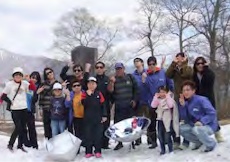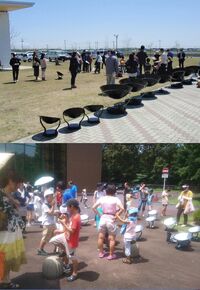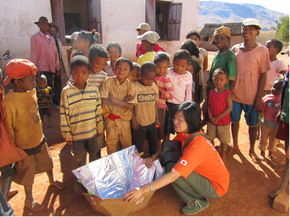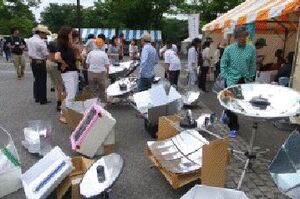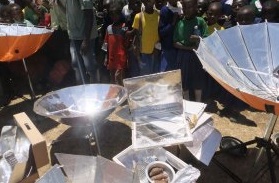Paul Hedrick (talk | contribs) |
Tom Sponheim (talk | contribs) mNo edit summary Tag: Source edit |
||
| (72 intermediate revisions by 7 users not shown) | |||
| Line 1: | Line 1: | ||
{{GoogleTranslateLinks}} |
{{GoogleTranslateLinks}} |
||
| + | {{Updated|8|17|23}} |
||
| + | {{CountryPageHeader|Ashikaga1.jpg|The Japan Solar Cooker Preliminary Convention was held 22-23 November 2016 at the [[Ashikaga University]]. The gathering was led by Professor Yuichi Nakajo, with the goal of creating a network for collaboration among manufacturers, distributors, traders, researchers, and others with a strong interest in solar cooking. Approximately 100 invited participants were in attendance. Professor Nakajo is planning to hold a larger convention next year, which will be open to anyone interested in solar cooking.}} |
||
==Events== |
==Events== |
||
| + | {{JapanEvents}} |
||
| − | See [[Calendar of events]] |
||
| + | {{CalendarAndPastEvents}} |
||
| − | ==Recent News and Developments== |
||
| ⚫ | *'''November 2012: Yuichi Nakajo, Director of Collaborative Research Center Ashikaga |
||
| + | =={{HeadingNews}}== |
||
| ⚫ | |||
| + | [[File:Table-Type Solar Cooker image, 8-14-23.png|300px|thumb|The [[Table-Type Solar Cooker]], ''Image credit: Hideo Oguri'']] |
||
| ⚫ | |||
| + | *{{NewAug23}}'''July 2023:''' The [[Table-Type Solar Cooker]] was designed by Hideo Oguri (Haru) living in [[Japan]]. He presented the prototype at [[CONSOLFOOD 2023]]. It incorporates a [[parabolic solar cooker|parabolic reflector]] mounted under a tabletop work surface. Hideo comments that this design is better suited to lower angles of the sun, which are more typical in Japan, than traditional parabolic designs. The cooker also incorporates a dual-axis [[tracking]] system to follow the sun while cooking, a combination of light sensors and actuators. |
||
| ⚫ | *'''November 2012:''' [[Niconet Tsukuba]] has been introducing solar cookers to local citizens in |
||
| + | [[File:5th_Japan_solar_cooker_convention,_4-22-20.png|300px|thumb|Fifth Japan Solar Cooker Convention in Chikusei, Nov. 2017]] |
||
| + | *'''November 2017:''' The Fifth Japan Solar Cooker Convention took place on November 17th in Chikusei, [[Japan]], which was well attended. The event was organized by Professor Yuichi Nakajo of Ashikaga University. |
||
| + | [[File:SCI_article_(Japanese),_12-19-16.png|thumb|300px|[http://vignette3.wikia.nocookie.net/solarcooking/images/d/d6/SCI_article_%28Japanese%29%2C_12-19-16.png/revision/latest?cb=20161219230711 (click to larger image of article above)]]] |
||
| − | [[File:JSCA_festival_1,_12-8-12.jpg|thumb|300px|Eco Life Fair 2012]] |
||
| + | *{{NewDec16}}'''December 2016:''' Solar Cookers International in Japan: [http://vignette3.wikia.nocookie.net/solarcooking/images/d/d6/SCI_article_%28Japanese%29%2C_12-19-16.png/revision/latest?cb=20161219230711 (click to larger image)] |
||
| − | [[File:JSCA_festival_2,_12-8-12.jpg|right|300px]] |
||
| − | [[File:JSCA_festival_3,_12-8-12.jpg|right|300px]] |
||
| ⚫ | *'''June 2012:''' The [[Japan Solar Cooking Association|JSCA]] participated in "Eco Life Fair 2012" held on June 2nd and 3rd at Yoyogi Park in central Tokyo. The fair was sponsored by the Ministry of the Environment, and was attended by 66,000 visitors. We exhibited many types of solar cookers and demonstrated solar cooking in the "Solar Zone" created for the first time this year. We cooked rice, made popcorn, and baked cakes and cookies. |
||
| + | [[File:Ashikaga1.jpg|thumb|right|300px|Attendees at the Japan Solar Cooker Preliminary Convention.]] |
||
| ⚫ | *'''May 2012:''' The [[Japan Solar Cooking Association]] participated in "Jambo! Kiyosato Tanzania Village" held May |
||
| + | *'''November 2014:''' The Japan Solar Cooker Preliminary Convention was held 22-23 November 2016 at the [[Ashikaga University]]. The gathering was led by Professor Yuichi Nakajo, with the goal of creating a network for collaboration among manufacturers, distributors, traders, researchers, and others with a strong interest in solar cooking. Approximately 100 invited participants were in attendance. Professor Nakajo is planning to hold a larger convention next year, which will be open to anyone interested in solar cooking. |
||
| ⚫ | |||
| ⚫ | |||
| ⚫ | *'''October 2011:''' Two members of Japan Solar Cooking Association, [[Yasuko Torii]] and |
||
| + | *'''January 2014: JSEEA visit students in Fukushima Prefecture''' Members of the Japan Solar Energy Educational Association traveled to Fukushima Prefecture in May 2013 to conduct a workshop on solar cooking for children in this region impacted by radiation leaks from their nuclear power plant. SJEEA trainers told the students about climbing Mount Everest and using solar cookers in 2003. Although the group cooked fried eggs and tea instead of rice, SJEEA reports that the students enjoyed their first solar cooked meal. |
||
| ⚫ | |||
| ⚫ | |||
| − | {{clr}} |
||
| − | [[File:Japan_cooker.jpg|thumb|The [[Sunny Cooker (Ogawa)|Sunny Cooker]]]] |
||
| ⚫ | *'''November 2009:''' The |
||
| + | *'''September 2013:''' The [[Japan Solar Cooking Association]] (JSCA) participated in the Eco Life Fair on June 1 and 2 in central Tokyo’s Yoyogi Park. The fair received 78,000 visitors. To demonstrate the power of their solar cookers, JSCA made popcorn, cooked rice, and baked cakes and cookies. |
||
| ⚫ | *'''Spring 2007:''' Solar Cooker Challenge for Africa is the name of a proposed project by an NGO in Japan called [[Solar Cooker Japan]] (SCJ). Its goals are to promote the planting of the Jatropha trees while also promoting solar cooking using a new prototype: the [[Balloon Solar Cooker]] by Mr. |
||
| ⚫ | *'''November 2012: Yuichi Nakajo, Director of Collaborative Research Center Ashikaga University, reports on his solar cooker usage research''' - Yuichi Nakajo's area of interest is the development of solar cookers for use in mid-latitude regions. He concentrates on designing cookers that will work in Japan throughout the year. The [[solar panel cooker]], [[Educooker 003]], was designed to be robust, and at the same time offer good concentration for the wide range of the sun's elevation, by employing a ray tracing technique. Now we are going to put the durable plastic version, developed through the joint research with the Japanese largest aluminum foil company, Toyo Aluminum K. K., onto the market. Our other products include plastic concentrator types with discretely approximated parabolic reflectors for uniform and safe heating. To satisfy the need and wants from all users, we prepare the kits with various types with a wide price range. Many Japanese, say solar cookers are only educational materials and are not reliable, because you cannot use it on the rainy days. But I do not believe it. Last March I sent all the members in my laboratory the Educooker to several disaster areas by request, but unfortunately I did not receive any replies. I suspect most of them were never tried. We cannot force them to use solar cookers, but at least warm food and warm drink could be of considerable help. I reconfirmed the importance of everyday education of solar cooking for everyone. That is the reason I conduct more than fifty classes each year. For more information, contact Yuichi Nakajo at [mailto:nakajo@ashitech.ac.jp nakajo@ashitech.ac.jp]. |
||
| − | ==The History of Solar Cooking in {{PAGENAME}}== |
||
| + | ::<gallery widths="290" spacing="small"hideaddbutton="true"> |
||
| ⚫ | |||
| + | JSEEA Fukushima photo, 1-9-14.jpg|JSEEA visit students in Fukushima Prefecture |
||
| ⚫ | 1994 to organize activities for a range of environmental initiatives |
||
| + | Nakajo, Yuichi training, 12-8-12.jpg|Yuichi Nakajo solar cooking workshops |
||
| + | </gallery> |
||
| ⚫ | *'''November 2012:''' [[Niconet Tsukuba]] has been introducing solar cookers to local citizens in Japan to increase people’s awareness of environmental and global issues, as well as to make small changes from their fossil-fuel-centered lifestyles. Our programs are usually performed in an informal and relaxed manner, by our motto “Niconet’s 3E = Enjoy, Environment, and Eating.” Solar cooking is, in fact, effective for promoting communication with others. In 2011 -2012, we worked with the faculty of a local university to conduct an analysis on the efficiency of the [[Sun Peace]] solar cooker, which was developed by our member [[Yuko Tomioka]], by using thermo-graphic devices. We plan to include the results in our solar cooking recipe booklet, which will be available on the web this year. In recent years, we also have focused on hand-made “retained heat cookers”. We found that newspaper can be used as an effective material for insulation in the [[retained heat cooker]]. While we are mainly active in the local area in Japan, some members are also active in other countries. Our member [[Fumi Sakurai]] stayed in [[Madagascar]] for two years, where serious deforestation is evident. She introduced villagers to the solar cooker Sun Peace. This solar cooker is easy to make because it does not require measurement. She suggested to some key persons in villages to use aluminum sheets of used snack packages for reflective material. It was found to work successfully in the sun-rich climate. Some villagers who learned how to make/use solar cookers became “teachers” and started to share the skills with others. In Japan, introducing such information is also useful for educational purposes. |
||
| + | ::<gallery widths="290" spacing="small"hideaddbutton="true"> |
||
| ⚫ | |||
| + | Yuko Tomioka 2, 11-161-2.jpg |
||
| + | </gallery> |
||
| ⚫ | |||
| ⚫ | Japan has one particularly faithful solar cook, however. Her name is [[Yasuko Torii]], and she has invented a number of cookers that she displayed at several world conferences. One was a very small box cooker, the other a larger version made of an aluminum product used in Japan as a drip pan for ovens. She has been an active |
||
| ⚫ | *'''June 2012:''' The [[Japan Solar Cooking Association|JSCA]] participated in "Eco Life Fair 2012" held on June 2nd and 3rd at Yoyogi Park in central Tokyo. The fair was sponsored by the Ministry of the Environment, and was attended by 66,000 visitors. We exhibited many types of solar cookers and demonstrated solar cooking in the "Solar Zone" created for the first time this year. We cooked rice, made popcorn, and baked cakes and cookies. |
||
| − | promoter of solar cooking for over ten years. She had recently created a solar cooking mailing list for the country, with most of the individuals living in Tokyo. |
||
| ⚫ | *'''May 2012:''' The [[Japan Solar Cooking Association]] participated in "Jambo! Kiyosato Tanzania Village" held May 3 through the 5th, and hosted by the Educational Experiment Project in Kiyosato, Yamanashi Pref. The event introduced nature and culture of [[Tanzania]] with movies and craft shops. Since we have been promoting solar cookers in Tanzania for several years, we exhibited solar cookers and demonstrated solar cooking in the village. |
||
| − | Recently, an announcement was made about the manufacture in Japan of a household size parabolic for sale in the Japanese market. The device is a dish reflector, |
||
| ⚫ | *'''October 2011:''' Two members of Japan Solar Cooking Association, [[Yasuko Torii]] and Toyoko Nishikawa visited five villages around Kitulo National Park, located in the south western part of [[Tanzania]] to promote solar cooking. This was the fourth visit since January 2008. They exhibited parabolic cookers, handmade box and panel type cookers and demonstrated cooking at October Mpeto Festival 2011 held on October 2 in Matamba town. Many visitors watched and enjoyed tasting solar baked cakes and popcorn. |
||
| ⚫ | mounted on a tripod. One other related commercial product manufactured is a stainless steel |
||
| + | ::<gallery widths="290" spacing="small"hideaddbutton="true"> |
||
| ⚫ | |||
| ⚫ | |||
| + | </gallery> |
||
| ⚫ | |||
| − | ''[Information for this section was taken originally from [[Media:sam.pdf|State of the Art of Solar Cooking]] by Dr. [[Barbara Knudson]]]'' |
||
| ⚫ | |||
| ⚫ | *'''November 2009:''' The Ogawa Crown Company has begun manufacturing small, portable [[parabolic solar cooker]]s that fold up in a similar fashion to an umbrella. The 1-meter diameter reflective shell of the “Sunny Cooker” is made from a unique aluminum-coated polyester cloth, structurally supported from the center and along the outer edge by flexible plastic poles. This lightweight shell essentially hangs from a metal pot stand that sits atop a foldable tripod and is fixed to the shell at two points. The central pole of the tripod connects to the pot stand through a zipper in the shell. The vertical angle of the reflector is adjustable by zipping or unzipping the shell to the appropriate distance and literally locking the zipper in place with a key. The Sunny Cooker sells for approximately $350, weighs about 3.5 kilograms, and comes with an iron kettle. A sample of the Sunny Cooker was kindly provided to [[Solar Cookers International]] by the Japan Solar Energy Educational Association. [[SCI]] Staff and board members have experimented with the cooker and have successfully boiled water and cooked popcorn. The device has been shown at multiple events, including demonstrations at Google’s international headquarters in Mountain View, California, and at National Defense University and the Pentagon in Washington, DC. Reported in the [http://solarcooking.org/newsletters/scrnov09.htm November 2009 Solar Cooker Review]. |
||
| ⚫ | *'''Spring 2007:''' Solar Cooker Challenge for Africa is the name of a proposed project by an NGO in Japan called [[Solar Cooker Japan]] (SCJ). Its goals are to promote the planting of the Jatropha trees while also promoting solar cooking using a new prototype: the [[Balloon Solar Cooker]] by Mr. Toshi Omhura, one of the founders of SCJ. Mr. Kazimito was in Nairobi, [[Kenya]] recently, holding preliminary discussions with [[Solar Cookers International East Africa Office]] Director [[Margaret Owino]] about a partnership. A team from SCJ later followed with the prototype cookers for field tests in Kenya. SCI (EA) welcomes this new development and will conduct field tests on the new cookers on behalf of SCJ. Their goal is to enable in-country production of the same cookers, should they pass the field test. |
||
| − | ==Climate, Culture, and Special Considerations== |
||
| ⚫ | |||
| ⚫ | |||
| ⚫ | |||
| ⚫ | |||
| ⚫ | |||
*'''August 2008:''' [http://search.japantimes.co.jp/cgi-bin/fl20080831x2.html 'Backyard naturalist' finds it fun to be green] - ''Japan Times'' |
*'''August 2008:''' [http://search.japantimes.co.jp/cgi-bin/fl20080831x2.html 'Backyard naturalist' finds it fun to be green] - ''Japan Times'' |
||
| + | |||
| − | *[http://www.timesnews.co.ke/11april07/magazine/magazine1.html Diva’s magical melody for the environment] - ''Kenya Times'' |
||
| + | ==Audio and video== |
||
| + | *{{NewSep22}}'''September 2022:''' |
||
| + | ::[[File:Living in Tokyo without Public Electricity-2|thumb|400px|none]] |
||
| + | |||
| ⚫ | |||
| + | *{{NewJul16}}'''July 2014:''' [[Media:Durable_High_Power_Panel_Type_Solar_Cooker_and_Its_Effectiveness_Study_in_Ethiopia.pdf|Durable High Power Panel Type Solar Cooker and Its Effectiveness Study in Ethiopia]] - ''Yuichi Nakajo'' |
||
| + | |||
| ⚫ | |||
| + | {{ContinentInfo|}} |
||
| + | |||
| + | =={{HeadingHistory}}== |
||
| + | {{SubSection|Clean Energy Utilization Research Study Group}} |
||
| ⚫ | |||
| ⚫ | 1994 to organize activities for a range of environmental initiatives within the country. A Solar Energy Festival has been held annually in the north of Japan; the Solar Energy Society's International Symposium was first held in the country in 1992. Most Japanese people have not been interested in solar cooking for themselves, as they use gas or electricity for cooking, which they find satisfactory. But many view solar cooking as an opportunity to teach people about larger energy issues. A book on solar cooking, "Cooking by the Sun" was published in Japanese in 1995, edited by members of the group. It includes and several types of cookers manufactured in Japan, which are largely for learning more about the technology and used in research. |
||
| + | {{SubSection|Yasuko Torii}} |
||
| ⚫ | Japan has had one particularly faithful solar cook, however. Her name is [[Yasuko Torii]], and she has invented a number of cookers that she displayed at several world conferences. One was a very small box cooker, the other a larger version made of an aluminum product used in Japan as a drip pan for ovens. She has been an active promoter of solar cooking for many years. She created a solar cooking mailing list for the country, with most of the individuals living in Tokyo. |
||
| + | |||
| ⚫ | Recently, an announcement was made about the manufacture in Japan of a household size parabolic for sale in the Japanese market. The device is a dish reflector, mounted on a tripod. One other related commercial product manufactured is a stainless steel well-insulated [[Heat-retention cooking|hay box]] made by Toyota, and has been sold in various countries. Both devices are expensive and not well suited for poor countries, but they could be marketed to middle class audiences in Asia, Europe, and North America. |
||
| + | {{ArchivedPagesForHistory}} |
||
| + | =={{HeadingClimateCulture}}== |
||
| + | '''See also:''' |
||
| + | *{{WikipediaClimate|https://en.wikipedia.org/wiki/Geography_of_Japan#Climate}} |
||
| ⚫ | |||
| + | |||
===Solar cooking blogs=== |
===Solar cooking blogs=== |
||
*[http://solarcookersinfo.blog2.fc2.com/ Solar Cookers Info] |
*[http://solarcookersinfo.blog2.fc2.com/ Solar Cookers Info] |
||
===Web pages=== |
===Web pages=== |
||
* [http://solarcooking.org/japanese/solarcooking-faq-ja.html Frequently-Asked Questions "Japanese"] |
* [http://solarcooking.org/japanese/solarcooking-faq-ja.html Frequently-Asked Questions "Japanese"] |
||
| − | * [http:// |
+ | * [http://amane-studio.jp ソーラークッカーのサイトです] |
===Books on solar cooking=== |
===Books on solar cooking=== |
||
| − | *[http://www.amazon.co.jp/Solar-Cooking-Footprint-Reading-Library/dp/1424044731?SubscriptionId=AKIAJHW6E7ZPYX5OJSAQ&tag=adsglory1-22&linkCode=sp1&camp=2025&creative=165953&creativeASIN=1424044731 Solar Cooking] - ''Heinle & Heinle Pub'' |
+ | *[http://www.amazon.co.jp/Solar-Cooking-Footprint-Reading-Library/dp/1424044731?SubscriptionId=AKIAJHW6E7ZPYX5OJSAQ&tag=adsglory1-22&linkCode=sp1&camp=2025&creative=165953&creativeASIN=1424044731 Solar Cooking] - ''Heinle & Heinle Pub'' |
| + | |||
| + | ==External links== |
||
| + | *{{NewApr20}}[http://www2.ashitech.ac.jp/mech/nakajo/Ehome.htm Nakajo Lab] chronicles the solar cooking history and projects initiated by Professor Yuichi Nakajo of [[Ashikaga University]]. |
||
{{CountryContacts}} |
{{CountryContacts}} |
||
| ⚫ | |||
| ⚫ | |||
[[Category:Countries]] |
[[Category:Countries]] |
||
| − | [[Category: |
+ | [[Category:Asia]] |
| ⚫ | |||
| ⚫ | |||
Latest revision as of 18:43, 14 January 2024
|
Last edited: 17 August 2023
|
|
The Japan Solar Cooker Preliminary Convention was held 22-23 November 2016 at the Ashikaga University. The gathering was led by Professor Yuichi Nakajo, with the goal of creating a network for collaboration among manufacturers, distributors, traders, researchers, and others with a strong interest in solar cooking. Approximately 100 invited participants were in attendance. Professor Nakajo is planning to hold a larger convention next year, which will be open to anyone interested in solar cooking.
|
Events[]
Featured international events[]
- 4-6 June 2024 (Bridgetown, Barbados): Sustainable Energy for All Global Forum - The event will be co-hosted by Sustainable Energy for All (SEforALL) and the government of Barbados. It is a platform for government, business and finance leaders, entrepreneurs, and youth and community representatives from around the world to come together to broker new partnerships, spur new investment, and address challenges at the nexus of energy, climate, and development. More information...
Online events[]
- NEW: Thursday, 18 April 2024 (2:30pm-3:15pm EDT), (Washington, D.C., USA): ESMAP Spring Meetings Knowledge Café: Clean Cooking at the Heart of Energy Access - Join ESMAP for this exciting knowledge-sharing opportunity, which will showcase the role of clean cooking as a key part of energy access and energy transition. Presentations by René van Hell, Director of Inclusive Growth, Ministry of Foreign Affair, Netherlands, Dr. Kandeh Yumkella Chairman, Presidential Initiative on Climate, Renewable Energy and Food Security, Sierra Leone, and Chandrasekar Govindarajalu, Practice Manager, ESMAP, World Bank. In-person attendance at World Bank Atrium, MC Front Lobby is for Spring Meetings registrants only. However, you can watch the event online
Requests for proposal[]
- Decentralized Renewable Energy Solutions utilizing Solar and Bio-Energy - Sustainable Energy Technologies and Assessments of ScienceDirect, is requesting guest-author submissions. The special issue, VSI: DRES is devoted to publishing research articles reporting the innovative designs and design interventions in solar thermal and bio-energy for decentralized energy systems (DES). It includes i) new and novel designs of prototype or commercial devices and technologies, their development, modeling and simulations and experimental validation; ii) innovations for processes, techniques, utilization, and applications; iii) novel use of materials for improving efficiency, performance, techno-economic feasibility, and sustainability and iv) research findings addressing the socio-economic, health and safety impacts, and life cycle assessments leading to proposing novel devices for DES. The Deadline for submission is 31 July 2024. More submittal information...
- See also: Global Calendar of Events and past events in Japan
News[]

The Table-Type Solar Cooker, Image credit: Hideo Oguri
- July 2023: The Table-Type Solar Cooker was designed by Hideo Oguri (Haru) living in Japan. He presented the prototype at CONSOLFOOD 2023. It incorporates a parabolic reflector mounted under a tabletop work surface. Hideo comments that this design is better suited to lower angles of the sun, which are more typical in Japan, than traditional parabolic designs. The cooker also incorporates a dual-axis tracking system to follow the sun while cooking, a combination of light sensors and actuators.
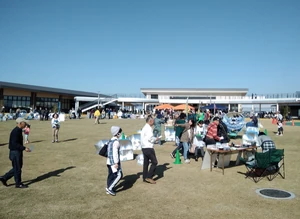
Fifth Japan Solar Cooker Convention in Chikusei, Nov. 2017
- November 2017: The Fifth Japan Solar Cooker Convention took place on November 17th in Chikusei, Japan, which was well attended. The event was organized by Professor Yuichi Nakajo of Ashikaga University.
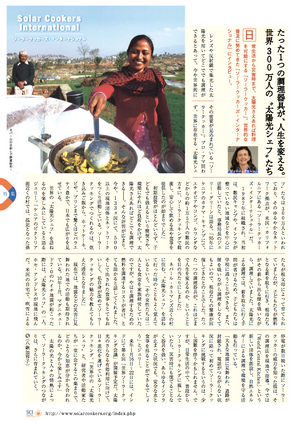
- December 2016: Solar Cookers International in Japan: (click to larger image)
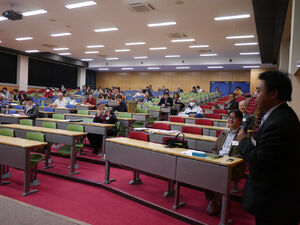
Attendees at the Japan Solar Cooker Preliminary Convention.
- November 2014: The Japan Solar Cooker Preliminary Convention was held 22-23 November 2016 at the Ashikaga University. The gathering was led by Professor Yuichi Nakajo, with the goal of creating a network for collaboration among manufacturers, distributors, traders, researchers, and others with a strong interest in solar cooking. Approximately 100 invited participants were in attendance. Professor Nakajo is planning to hold a larger convention next year, which will be open to anyone interested in solar cooking.
- January 2014: JSEEA visit students in Fukushima Prefecture Members of the Japan Solar Energy Educational Association traveled to Fukushima Prefecture in May 2013 to conduct a workshop on solar cooking for children in this region impacted by radiation leaks from their nuclear power plant. SJEEA trainers told the students about climbing Mount Everest and using solar cookers in 2003. Although the group cooked fried eggs and tea instead of rice, SJEEA reports that the students enjoyed their first solar cooked meal.
- September 2013: The Japan Solar Cooking Association (JSCA) participated in the Eco Life Fair on June 1 and 2 in central Tokyo’s Yoyogi Park. The fair received 78,000 visitors. To demonstrate the power of their solar cookers, JSCA made popcorn, cooked rice, and baked cakes and cookies.
- November 2012: Yuichi Nakajo, Director of Collaborative Research Center Ashikaga University, reports on his solar cooker usage research - Yuichi Nakajo's area of interest is the development of solar cookers for use in mid-latitude regions. He concentrates on designing cookers that will work in Japan throughout the year. The solar panel cooker, Educooker 003, was designed to be robust, and at the same time offer good concentration for the wide range of the sun's elevation, by employing a ray tracing technique. Now we are going to put the durable plastic version, developed through the joint research with the Japanese largest aluminum foil company, Toyo Aluminum K. K., onto the market. Our other products include plastic concentrator types with discretely approximated parabolic reflectors for uniform and safe heating. To satisfy the need and wants from all users, we prepare the kits with various types with a wide price range. Many Japanese, say solar cookers are only educational materials and are not reliable, because you cannot use it on the rainy days. But I do not believe it. Last March I sent all the members in my laboratory the Educooker to several disaster areas by request, but unfortunately I did not receive any replies. I suspect most of them were never tried. We cannot force them to use solar cookers, but at least warm food and warm drink could be of considerable help. I reconfirmed the importance of everyday education of solar cooking for everyone. That is the reason I conduct more than fifty classes each year. For more information, contact Yuichi Nakajo at nakajo@ashitech.ac.jp.
- November 2012: Niconet Tsukuba has been introducing solar cookers to local citizens in Japan to increase people’s awareness of environmental and global issues, as well as to make small changes from their fossil-fuel-centered lifestyles. Our programs are usually performed in an informal and relaxed manner, by our motto “Niconet’s 3E = Enjoy, Environment, and Eating.” Solar cooking is, in fact, effective for promoting communication with others. In 2011 -2012, we worked with the faculty of a local university to conduct an analysis on the efficiency of the Sun Peace solar cooker, which was developed by our member Yuko Tomioka, by using thermo-graphic devices. We plan to include the results in our solar cooking recipe booklet, which will be available on the web this year. In recent years, we also have focused on hand-made “retained heat cookers”. We found that newspaper can be used as an effective material for insulation in the retained heat cooker. While we are mainly active in the local area in Japan, some members are also active in other countries. Our member Fumi Sakurai stayed in Madagascar for two years, where serious deforestation is evident. She introduced villagers to the solar cooker Sun Peace. This solar cooker is easy to make because it does not require measurement. She suggested to some key persons in villages to use aluminum sheets of used snack packages for reflective material. It was found to work successfully in the sun-rich climate. Some villagers who learned how to make/use solar cookers became “teachers” and started to share the skills with others. In Japan, introducing such information is also useful for educational purposes.
- Niconet Tsukuba introduces solar cooking in Madagascar with the Sun Peace solar cooker
- June 2012: The JSCA participated in "Eco Life Fair 2012" held on June 2nd and 3rd at Yoyogi Park in central Tokyo. The fair was sponsored by the Ministry of the Environment, and was attended by 66,000 visitors. We exhibited many types of solar cookers and demonstrated solar cooking in the "Solar Zone" created for the first time this year. We cooked rice, made popcorn, and baked cakes and cookies.
- May 2012: The Japan Solar Cooking Association participated in "Jambo! Kiyosato Tanzania Village" held May 3 through the 5th, and hosted by the Educational Experiment Project in Kiyosato, Yamanashi Pref. The event introduced nature and culture of Tanzania with movies and craft shops. Since we have been promoting solar cookers in Tanzania for several years, we exhibited solar cookers and demonstrated solar cooking in the village.
- October 2011: Two members of Japan Solar Cooking Association, Yasuko Torii and Toyoko Nishikawa visited five villages around Kitulo National Park, located in the south western part of Tanzania to promote solar cooking. This was the fourth visit since January 2008. They exhibited parabolic cookers, handmade box and panel type cookers and demonstrated cooking at October Mpeto Festival 2011 held on October 2 in Matamba town. Many visitors watched and enjoyed tasting solar baked cakes and popcorn.
- Japan Solar Cooking Association visits Tanzania October, 2011.Japan Solar Cooking Association visits Tanzania October, 2011
- October 2010: Mr. Ohmura has designed an inflatable version of a parabolic solar cooker. It is called the Balloon Solar Cooker.

Solar cooker from JP (Balloon Cooking)
- November 2009: The Ogawa Crown Company has begun manufacturing small, portable parabolic solar cookers that fold up in a similar fashion to an umbrella. The 1-meter diameter reflective shell of the “Sunny Cooker” is made from a unique aluminum-coated polyester cloth, structurally supported from the center and along the outer edge by flexible plastic poles. This lightweight shell essentially hangs from a metal pot stand that sits atop a foldable tripod and is fixed to the shell at two points. The central pole of the tripod connects to the pot stand through a zipper in the shell. The vertical angle of the reflector is adjustable by zipping or unzipping the shell to the appropriate distance and literally locking the zipper in place with a key. The Sunny Cooker sells for approximately $350, weighs about 3.5 kilograms, and comes with an iron kettle. A sample of the Sunny Cooker was kindly provided to Solar Cookers International by the Japan Solar Energy Educational Association. SCI Staff and board members have experimented with the cooker and have successfully boiled water and cooked popcorn. The device has been shown at multiple events, including demonstrations at Google’s international headquarters in Mountain View, California, and at National Defense University and the Pentagon in Washington, DC. Reported in the November 2009 Solar Cooker Review.
- Spring 2007: Solar Cooker Challenge for Africa is the name of a proposed project by an NGO in Japan called Solar Cooker Japan (SCJ). Its goals are to promote the planting of the Jatropha trees while also promoting solar cooking using a new prototype: the Balloon Solar Cooker by Mr. Toshi Omhura, one of the founders of SCJ. Mr. Kazimito was in Nairobi, Kenya recently, holding preliminary discussions with Solar Cookers International East Africa Office Director Margaret Owino about a partnership. A team from SCJ later followed with the prototype cookers for field tests in Kenya. SCI (EA) welcomes this new development and will conduct field tests on the new cookers on behalf of SCJ. Their goal is to enable in-country production of the same cookers, should they pass the field test.
Articles in the media[]
- August 2008: 'Backyard naturalist' finds it fun to be green - Japan Times
Audio and video[]
- September 2022:
Reports[]
- July 2014: Durable High Power Panel Type Solar Cooker and Its Effectiveness Study in Ethiopia - Yuichi Nakajo
Resources[]
Possible funding[]
History[]
The Clean Energy Utilization Research Study Group was established in Japan in 1994 to organize activities for a range of environmental initiatives within the country. A Solar Energy Festival has been held annually in the north of Japan; the Solar Energy Society's International Symposium was first held in the country in 1992. Most Japanese people have not been interested in solar cooking for themselves, as they use gas or electricity for cooking, which they find satisfactory. But many view solar cooking as an opportunity to teach people about larger energy issues. A book on solar cooking, "Cooking by the Sun" was published in Japanese in 1995, edited by members of the group. It includes and several types of cookers manufactured in Japan, which are largely for learning more about the technology and used in research.
Japan has had one particularly faithful solar cook, however. Her name is Yasuko Torii, and she has invented a number of cookers that she displayed at several world conferences. One was a very small box cooker, the other a larger version made of an aluminum product used in Japan as a drip pan for ovens. She has been an active promoter of solar cooking for many years. She created a solar cooking mailing list for the country, with most of the individuals living in Tokyo.
Recently, an announcement was made about the manufacture in Japan of a household size parabolic for sale in the Japanese market. The device is a dish reflector, mounted on a tripod. One other related commercial product manufactured is a stainless steel well-insulated hay box made by Toyota, and has been sold in various countries. Both devices are expensive and not well suited for poor countries, but they could be marketed to middle class audiences in Asia, Europe, and North America.
- Main article: History of solar cooking
Archived articles
Climate and culture[]
See also:
Solar cooking blogs[]
Web pages[]
Books on solar cooking[]
- Solar Cooking - Heinle & Heinle Pub
External links[]
- Nakajo Lab chronicles the solar cooking history and projects initiated by Professor Yuichi Nakajo of Ashikaga University.
Contacts[]
The entities listed below are either based in Japan, or have established solar cooking projects there:
SCI Associates[]
- Main article: Solar Cookers International Association




